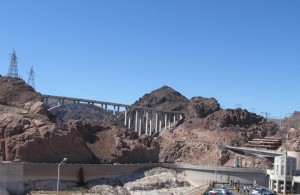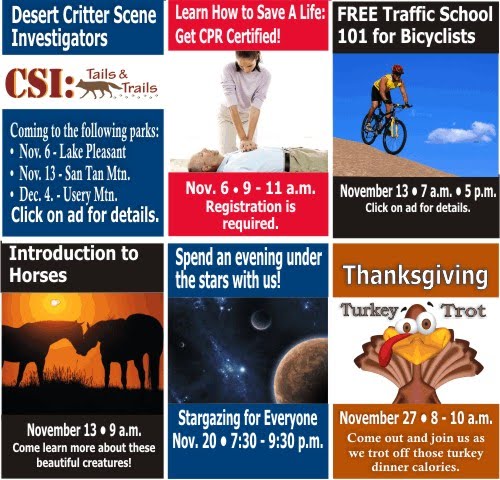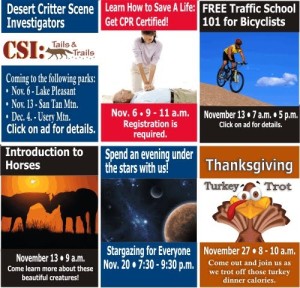Month: October 2010
Bicyclists are urged to attend the Public Meeting this Thursday 5:30 pm Sunnyslope High School, 35 W Dunlap Rd, Phoenix
When:
October 28th, 2010,
5:30 p.m. to 7:30 p.m.
Where:
Sunnyslope High School
35 W. Dunlap Avenue
Phoenix, Arizona 85021
East Parking Lot in the
Viking Conference Rm.
Questions:
Call the 24-Hour Hotline at:
1-877-349-1433
LAB’s Traffic Skills 101 class – Explained
Traffic Skills 101 is a hands-on class of effective cycling. It was originally created by John Forester and taught as a college-level class at Berkeley. Over the years, the League of American Bicyclists (LAB) has refined it and the current version is known as Traffic Skills 101. The name is more telling of the content as well as the level of detail included.
-
Bicycle and helmet fit, and why each is important.
-
Pre-ride check of your bicycle to catch problems before they spoil your ride.
-
Respect for and from other users of the roads.
-
Best lane position regarding your destination, road conditions and traffic conditions.
-
Visibility, both day and night.
-
A fine-tooth comb examination of applicable state law, and what it requires of both motorists and cyclists.
-
The pros and cons of both properly installed bike lanes and road markings that are often, and sometimes disastrously, mistaken for bike lanes.
-
Parking lot skills training for precise control of your bicycle as well as maneuvers to avoid mistakes of others.
-
Actual crash and injury data showing the contributing factors, thus giving the ability to anticipate mistakes of others, as well as what not to do yourself.
-
Knowledge of what skills to use should you need to protect yourself.
-
Tire changing and flat fixing. What tools and spare parts to bring with you.
-
Hydration and eating.
-
Best pedaling rate for endurance and how gears are used to help you in this matter.
-
Special cases, such as, railroad crossings, up and down hill rides, wet weather and cycling on multi-use paths where slow and fast cyclists, children, pedestrians and horses may be sharing the path.
-
Actual riding in traffic on a predetermined route that includes many considerations covered in the classroom. Includes many stops for rest and evaluation of conditions encountered.
-
Written test that is a review of classroom and road experience.
-
Graduation, the proof of accomplishing these objectives.
-
Finally, our mantra, over and over again: “Cyclists fare best when they act as, and are treated as, drivers of slow vehicles.”
Peopleforbikes: sign the pledge
Last week, peopleforbikes.org reached an important milestone when it topped 100,000 pledges for better bicycling. Read/sign the pledge here.
TS101 Bike Ed Class at Lake Pleasant: Nov 13th
For other Bike Ed class dates and locations visit www.cazbike.org/BikeEd
* with $6 park entry fee
Tour de Safford coming up Oct 30, Named Official Training Ride for El Tour de Tucson
Perimeter Bicycling Association of America, Inc. has recently agreed to naming the first “Tour de Safford” as an official training ride for the 28th El Tour de Tucson.Tour de Safford, presented by the Gila Valley Health Raisers with proceeds benefitting Mt Graham Regional Medical Center, will be held on Saturday, October 30, 2010, three weeks prior to the 28th El Tour which is scheduled for Saturday, November 20th.
This is the first time in El Tour’s 28-year history that event officials have ever named another ride as an official training ride for El Tour. Perimeter Bicycling played a major role in helping to develop this new event. As it is basically modeled after El Tour, and held three weeks prior to El Tour Day, Tour de Safford could benefit all El Tour cyclists by becoming a training ride for El Tour. Although Tour de Safford is not a Perimeter event, Perimeter Bicycling Association of America recognizes that is has all the components for a quality ride.
Tour de Safford is a timed event like El Tour. T-shirts and medallions will be awarded to all cyclists. Registration includes a processing fee of $10 until August 1st (after which it will increase every month) plus an entry fee of $50. Cyclists have a choice of riding, 104, 69 or 33 miles. It is a family event with a 1/2 marathon, airplane exhibit, car show, poker run/motorcycle show, live music, food and more.
Take the opportunity for a scenic ride through the Black Hills of Arizona. Get Ready for El Tour. Ride in the first annual Tour de Safford. Register now at www.tourdesafford.com.
CAzBike Membership Meeting: Monday Oct 18
next meeting: Monday Oct 18th, 2010. 6:00PM.
Location: Boulders on Broadway Bar and Grill (map)
530 W. Broadway in Tempe AZ 85282, 480.921.9431
Trek factoryDemo coming to AZ in November
The Trek Factory Demo was designed to make the best bicycles from Trek and Gary Fisher available to experience firsthand… And they’re coming to Arizona in November, visit trekfactorydemo.com for more info.
Cyclists given first access to hoover dam bridge
 As the amazing Hoover Dam Bypass project nears its opening to the public, cyclists were given first access… Our own Gene Holmerud, Coalition VP of Education, was interviewed by Channel 8 news at the event, in conjunction with the Viva Bike Vegas ride, click here to view.
As the amazing Hoover Dam Bypass project nears its opening to the public, cyclists were given first access… Our own Gene Holmerud, Coalition VP of Education, was interviewed by Channel 8 news at the event, in conjunction with the Viva Bike Vegas ride, click here to view.
Behind the Scenes and in the Trenches…
… Arizona Organization Works on Behalf of All Cyclists
by Sheila Foraker, Southern Arizona Rep to the CAzBike.
this article originally appeared in the Tailwind Times, Sept-Oct 2010.
September, 1973. A teenage cyclist is on the way to school. Approaching an intersection, she is forced by traffic into the gutter
where the front wheel of her bicycle slips into a storm drain grate that runs parallel to the direction of traffic. The cyclist is pitched off of her bike and fortunately sustains only minor injuries.
June, 1984. A motorist is preparing to execute a right turn onto a major arterial. The driver does not see a cyclist rapidly approaching on the sidewalk riding against traffic. The cyclists collides with the car but is not seriously injured.
May, 1996. A group of cyclists is riding single – file in the marked bike lane on a collector street. Each cyclist in the group of five signals and shoulder checks prior to beginning to merge left for a vehicular left turn. A motorist approaches from behind, honking the horn and revving the engine menacingly. The motorist drives his car into the group of cyclists who are able to avoid being struck, however, three of the riders do crash as a result. The driver of the car shouts obscenities at the riders and insists that they have no right to be on the road, then speeds off.
These three incidents all happened to me. I was a cyclist in two of the accounts, and the driver of the car who collided with a rider. Each of these incidents involves an aspect of bicycle safety, education and enforcement.
As cyclists, we are members of a population that has been referred to as “vulnerable users,” which generally includes anyone who is not encased in a two – ton metal box, and who could be seriously injured by said two – ton boxes. Nearly every bicyclist has felt vulnerable at some point – and frustration – but may not know where to turn or how to go about initiating change.
The three illustrations above represent infrastructure issues, the need for education, and law enforcement support. Since 1880 The League of American Wheelmen has been advocating for cyclists rights and for the creation of better roads. Now know as the League of American Bicyclists, the organization works in Washington, DC in all advocacy matters. Much of the federal funding that states receive for road improvements are evidence of the League’s efforts. Take for example my storm drain incident. The 1999 guide for the development of bicycle facilities, created by the American Association of State Highway and Transportation Officials, specifies that grates with bars parallel to the direction of travel should be physically corrected “as soon as practicable after they’re identified.” As a result of representation in the legislature positive changes do happen to improve the safety of cyclists.
National representation is great, but where do Arizona cyclists turn for similar representation in the state legislature?
Bill Heimann, Reed Kempton, Bill Lazenby, and the late Richard Metz recognized that there was no voice for cyclists when dealing with government agencies on statewide issues. The Coalition of Arizona Bicyclists was formed in 1991 and is a 501c3 non-profit organization.
The mission of the Coalition of Arizona Bicyclists is to promote efforts that improve bicycling usage and safety within the state of Arizona by addressing law enforcement and transportation engineering issues. This is accomplished through education, outreach, and advocacy programs. The goal is to enhance the role of bicycling in local, county and statewide transportation plans. The Coalition is a cyclist’s voice in the fight for bicycling rights, and is involved in local organizations such as the Arizona Department of Transportation (ADOT) and the Maricopa Association of Governments (MAG).
There is a misconception that the Coalition of Arizona Bicyclists only places emphasis on Phoenix or Maricopa County issues. That is not the case. Just as the League of American Bicyclists is based in Washington, DC, in order to facilitate participation in legislative meetings, similarly, the Coalition is based in Arizona’s capitol city, Phoenix, with representatives in Yavapai, Pima and Graham counties. The Coalition recently wrote two letters to Pima County and Tucson government and law enforcement regarding Golf Links Road and the Tucson Mountain Park to express concern and to praise positive efforts.
Individuals, clubs and bike shops are encouraged to become members of the Coalition. Membership dues may be tax deductible and go toward making Arizona a safer place to enjoy bicycling.
The Coalition offers bicycle safety classes utilizing the League of American Bicyclists Traffic Skills curriculum, and the classes are taught by League Certified Instructors. Class participants learn the laws of the road – which, by the way, are the same for motorists: Same roads, same rules, same rights and responsibilities. Traffic Skills classes are taught in Yavapai, Pima, Maricopa, and Graham counties.
Sometimes the unthinkable happens and a cyclist is involved in a crash with a motor vehicle or is injured due to infrastructure flaws. That is where the Coalition can step in.
The Outreach program is designed to assist the survivors of a bicycle related fatality. For the survivors, the emotional trauma can be devastating. Recognizing that one person or organization cannot do everything, the Coalition has partnered with the Not One More Foundation. Not One More Foundation offers resources, meals, household services, professional references, and financial grants to assist the families of cyclists injured or killed in crashes involving a motor vehicle.
Positive results can come out of tragedy. After a cyclist was killed on Highway 179, the Verde Valley Cyclists Coalition (a member club of the Coalition of Arizona Bicyclists) was an instrumental contributor to Arizona DOT’s first ever “Context Sensitive Solution” project to re-design Highway 179 from just outside the Village of Oak Creek into the center of Sedona. Previously, it was extremely dangerous to ride a bicycle on that route with its narrow road, poor line of sight and no shoulder. Now, the Sedona/Village of Oak Creek area is truly bicycle – friendly. Bike lanes, roundabouts with 15 mph speed limits, and ramps to and from a side path are all new features resulting from the project. What was once a hazardous corridor is now a safe route, which allows bicyclists and motorists to share the scenic route between those two communities. Other advantages of the ADOT improvements are that mountain bikers can “commute” to their favorite trails by bike lane, and center left turn lanes are designed to help avoid incursions by vehicles into bike lanes. A number of scenic – view parking lots are available, and there are curbs to prevent motor traffic from pulling off to the side of the road, which would pose a danger to cyclists.
In 2008 The Coalition of Arizona Bicyclists hosted an education conference where traffic engineers, law enforcement and cyclists met to discuss concerns and solutions to the challenges facing bicyclists. The conference was held in conjunction with El Tour de Phoenix and Andy Clarke, Executive Director of the League of American Bicyclists, was a featured speaker.
The Coalition of Arizona Bicyclists is a statewide organization that works hard for cyclists’ rights in Arizona, but it is only a strong as its membership. Consider joining the Coalition. Bike clubs, individuals and bike shops are invited to bring their collective talents to the table to work toward a bicycle – friendly state, starting in your neighborhood. For more information, please visit the web site at www.cazbike.org/.
Tweet






